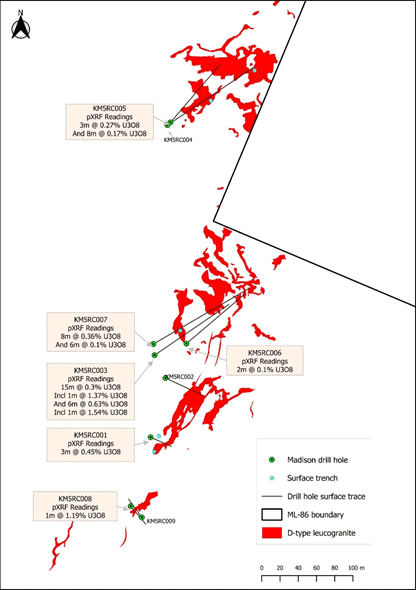Madison Metals Inc. (“Madison”) is pleased to announce that it has completed its maiden drill program of nine holes (997 m) of Reverse Circulation (RC) drilling at its Khan Uranium Project at Madison West, located in Namibia’s Central Erongo Uranium province, and confirmed high-grade uranium deposits. Uranium mineralization was successfully intersected at depth in six of the nine drill holes.
 Location of the drill holes and significant observations. Image Credit: Madison Metals Inc.
Location of the drill holes and significant observations. Image Credit: Madison Metals Inc.
The most significant observations during the Company’s chip logging include:
- Elevated pXRF* readings from chips with a maximum value of 1.54 % U3O8
- Multiple mineralized zones intersected included a 15-meter (m) mineralized zone averaging pXRF 0.3 % U3O8
- Fresh mineralized D-type leucogranite characterized by smoky quartz
- Uranium mineralization at depth in six drill holes
The recent nine holes confirm Madison’s geological expectations and logging has confirmed that uranium-bearing D-type alaskites have intruded the Khan group which is comprised of calc-silicates, quartzites and schists at depth.
“We are excited and encouraged by the results of our maiden drill program, having successfully intersected uranium mineralization at depth in six out of the nine holes drilled. This achievement marks a significant step forward in our exploration program,” says Dr. Roger Laine, a Director of Madison and geological engineer with 40+ years of expertise in advanced mineral exploration projects. “The confirmed stratigraphic level on the property provides the ideal conditions for high-grade alaskite-hosted uranium mineralization similar to that at the Rossing and Husab Mines in Namibia.”
The drill holes targeted various previously identified uranium-bearing outcrops along the 12- kilometer Anomaly 5 target. The holes were drilled to determine the sub-surface extension of high-grade uranium mineralization, both laterally and at depth. Uranium mineralization was intersected in six of the nine drill holes, with logged yellow product observed over the highest-grade intervals.
KM5RC001 was drilled to intercept mineralization between the surface Trenches KM5TR001 and KM5TR002. The drill hole intercepted a 3 m mineralized alaskite starting at 19 m below surface.
Two holes (KM5RC003 and KM5RC007) were drilled under the surface trench KM5TR003 and were extended to intercept a surface expression 50 m from the trench. Both holes intercepted multiple lenses of mineralized alaskites of more than 2 m thickness starting at 35 m below surface. The deepest mineralized alaskites were intersected at 114 m below surface in both drill holes.
The drilling has yielded significant achievements, even under challenging conditions. Due to ground accessibility issues, a set of fan holes (KM5RC005 and KM5RC006) was also drilled to intersect KM5TR004 and KM5TR005. KM5RC005 confirmed mineralization starting at 46 m below surface.
KM5RC008 and KM5RC009 were drilled to test the surface mineralization and alaskite orientation south of KM5TR001. KM5RC008 intersected a 1 m thick alaskite at 33 m below surface with a pXRF reading of 1.19 % U3O8.
Some RC chip samples have been sent for analysis, and final analytical assay results are expected in the coming weeks. Follow-up drilling is being planned to further define the lateral and vertical extent of uranium mineralization discovered to date.
pXRF on RC chips were taken using a single reading through the calico bag for every meter. In relation to the disclosure of pXRF results, the Company cautions that estimates of U3O8 ppm from pXRF results should not be considered a proxy for quantitative analysis of a laboratory assay result. Assay results are required to determine the actual widths and grade of the visible mineralization.
Drilling has been completed on multiple azimuths and as fan drilling with multiple holes collared from a single drill site to minimize surface disturbance, which will result in some oblique intercepts to target orientations. The true thickness of intercepts will be accounted for following structural drilling and 3D modelling. All results in relation to this news release are drilled thickness and should not be interpreted as true thickness at this time.
Qualified Person
Mary Barton, a Professional Natural Scientist (SACNASP) and a Qualified Person for the purposes of National Instrument 43-101 (NI 43-101) Standards of Disclosure for Mineral Projects for ML86A, has reviewed, verified, and approved the technical information contained in this news release.